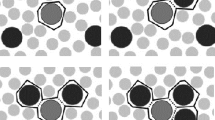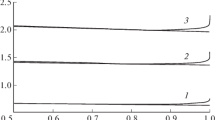Abstract
Alcohol-water mixtures are often used as model systems for the study of hydrophobic interactions. In this respect, their thermodynamic properties are of particular interest since precise data are available over the whole miscibility range and they lend themselves readily to theoretical modelling. Three association models have been used to fit the volume data taken from the literature for aqueous methonol, ethanol and n-propanol at various temperatures. A simple micellization equilibrium explains the general trends but fails to fit the reduced excess volumes at both ends of the mole fraction scale. Better fits are obtained if interaction parameters are introduced, but these two parameters cannot easily be rationalized. A double association model (one for the alcohol and one for the water) gives the best fit and all the parameters have a physical significance. However, the parameters extracted, e.g. aggregation numbers, and their trends with temperature are not always realistic. Despite their limitations, these models illustrate well with the kind of avenues that can be explored to fit and interpret the experimental data of these complex systems.
Similar content being viewed by others
References
Andreae J H, Edmonds P D and McKellar J F 1965Acustica 15 74
Benson C G and Kiyohara O 1980J. Solution Chem. 9 791
Desnoyers J E, Caron G, DeLisi R, Roberts D, Roux A H and Perron G 1983.J. Phys. Chem. 87 1397
Desnoyers J E and Jolicoeur C 1982Treaties of electrochemistry (eds.) J O'M Bockris, B E Conway and E Yeager (New York: Plenum Press) chap. 1
Desnoyers J E, Perron G and Roux A H 1986Surfactant solutions: New methods of investigation. (ed.) R. Zana (New York: Marcel Dekker) p. 1
Desnoyers J E, Roberts D, DeLisi R and Perron G 1982.Solution behaviour of surfactants (eds) K L Mittal and E J Fendler (New York: Plenum Press) vol. 1, p. 343
Dethlefsen C, Sorensen P G and Hvidt A (1984)J. Solution Chem. 13 191
Donkerslott M C A 1979.J. Solution Chem. 8 293
Franks F and Desnoyers J E 1985 inWater sciences reviews (ed.) F Franks, (Cambridge: Univ. Press) vol. 1, p. 171
Hvidt A 1978Acta Chem. Scand. A32 675
Iwasaki K, Tanaka M and Fujiyama T 1976Bull. Chem. Soc. Jpn. 49 2719
Iwasaki K and Fujiyama T 1977J. Phys. Chem. 81 1908
Iwasaki K and Fujiyama T 1979J. Phys. Chem. 83 463
Keiser, B A, Varle D, Barden R E and Holt S L 1979J. Phys. Chem. 83 1276
Kozak J J, Knight W S and Kauzmann W (1968J. Chem. Phys. 48 151
Lara J, Perron G and Desnoyers J E 1981J. Phys. Chem. 85 1600
Mikhailov V A 1968Zh. Struk. Khim. 9 397
Mikhailov V A and Ponomareva L I 1968Zh. Struk. Khim. 9 12
Okasaki S, Touhara H and Nakanishi K 1984J Chem. Phys. 81 890
Prigogine I and Defay R 1950 inThermodynamique chimique (Liege: Desoer Publ.)
Roux A H, Hetu D, Perron G and Desnoyers J E 1984J. Solution Chem. 13 1
Roux-Desgranges G, Roux A H, Grolier J P and Viallard A 1982J. Solution Chem. 11 357
Smith G D, Donelan C E and Barden R E 1977J. Colloid Interface Sci. 60 488
Tanaka H, Nakanishi K and Touhara H 1984.J. Chem. Phys. 81 4065
Author information
Authors and Affiliations
Rights and permissions
About this article
Cite this article
Roux, A.H., Desnoyers, J.E. Association models for alcohol-water mixtures. Proc. Indian Acad. Sci. (Chem. Sci.) 98, 435–451 (1987). https://doi.org/10.1007/BF02861539
Issue Date:
DOI: https://doi.org/10.1007/BF02861539




